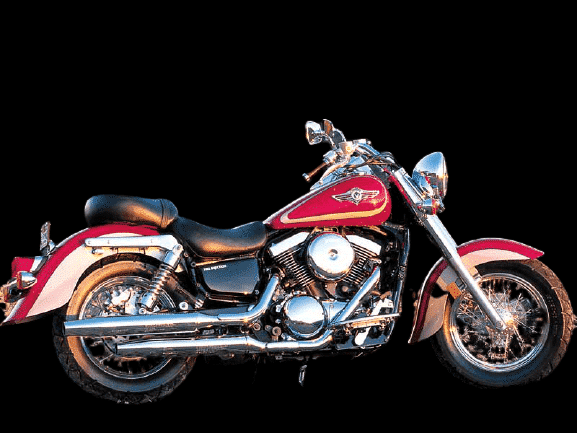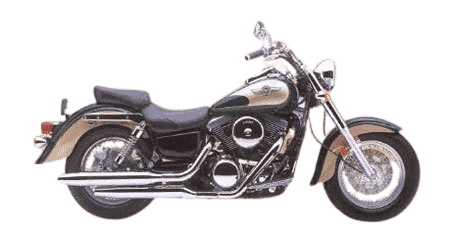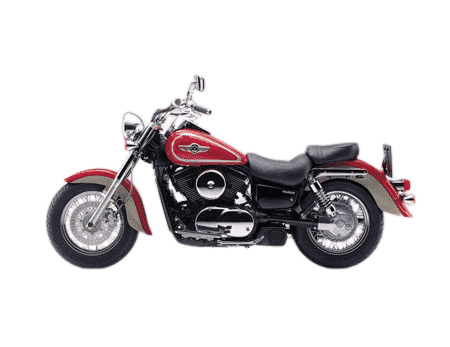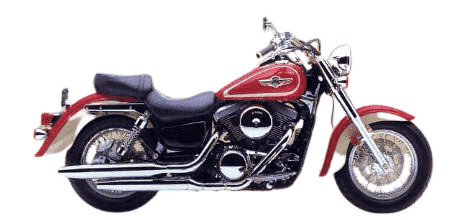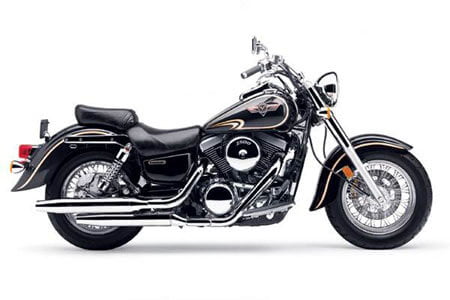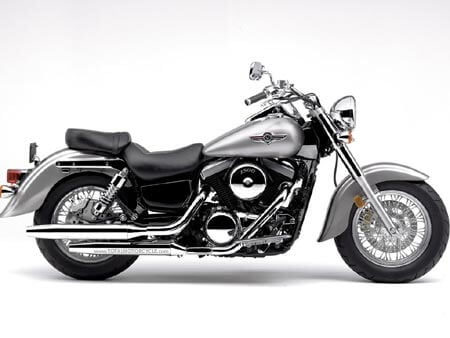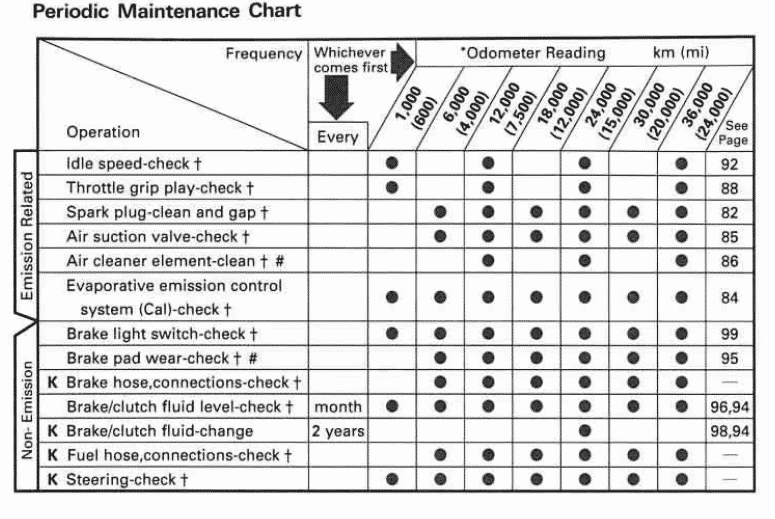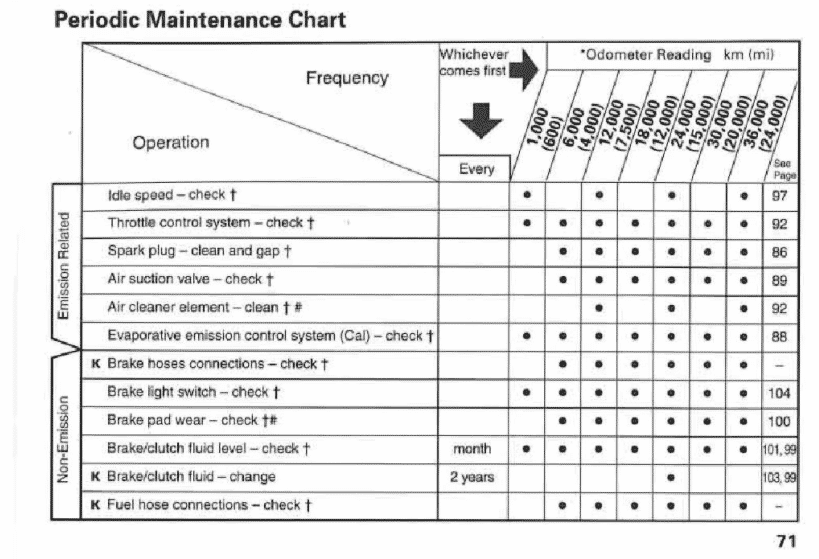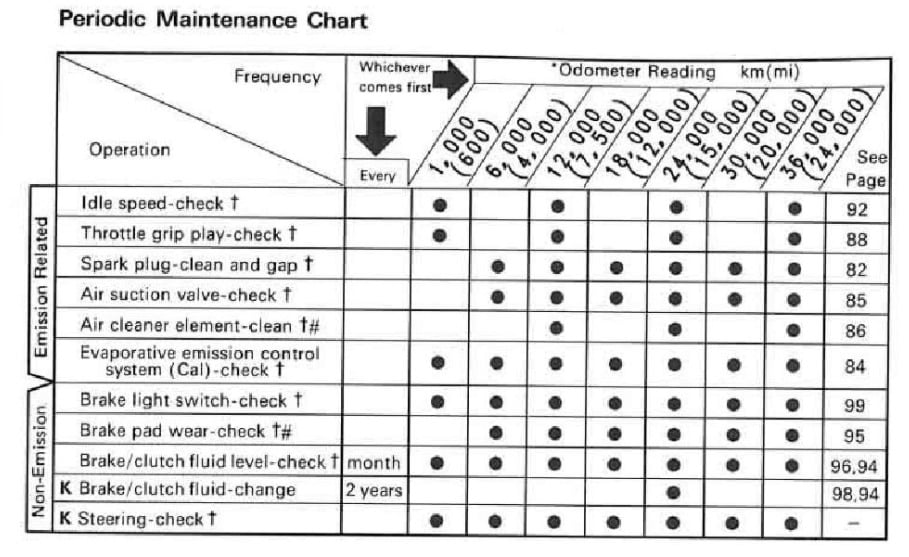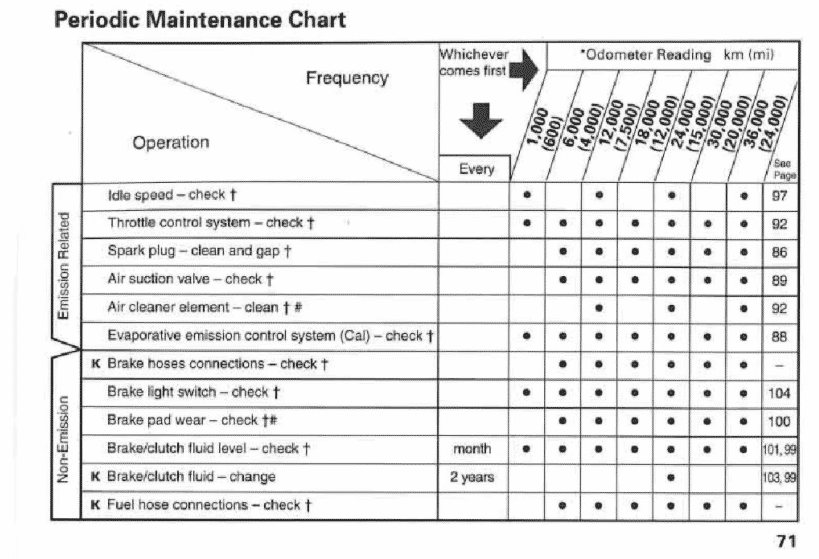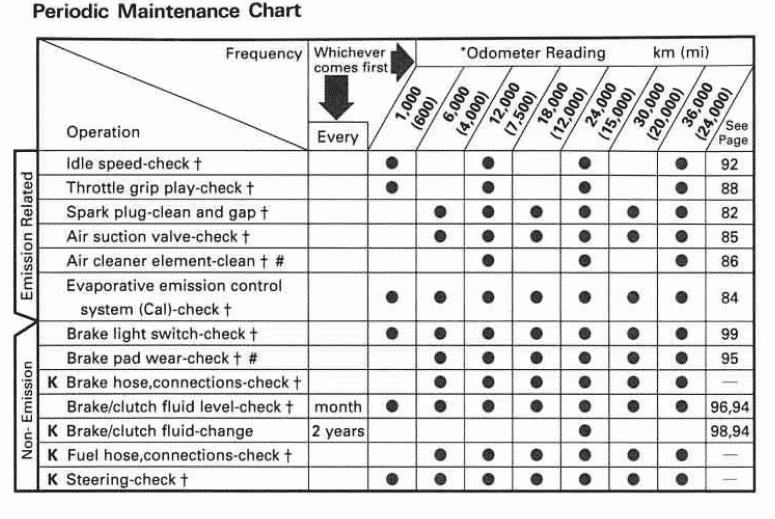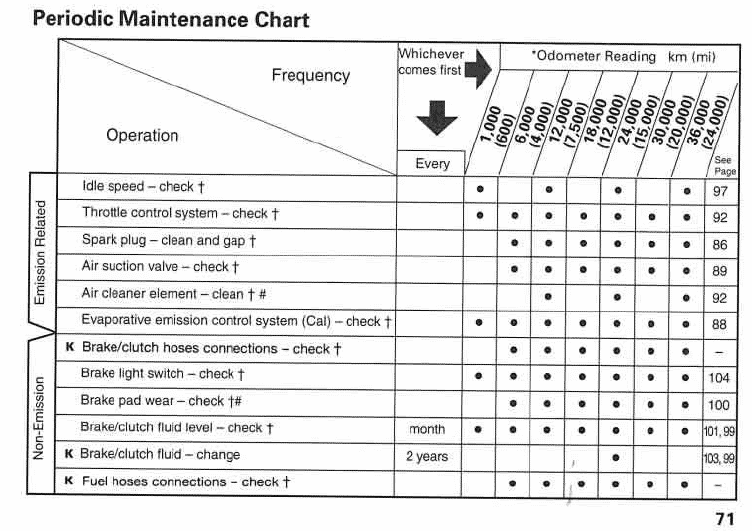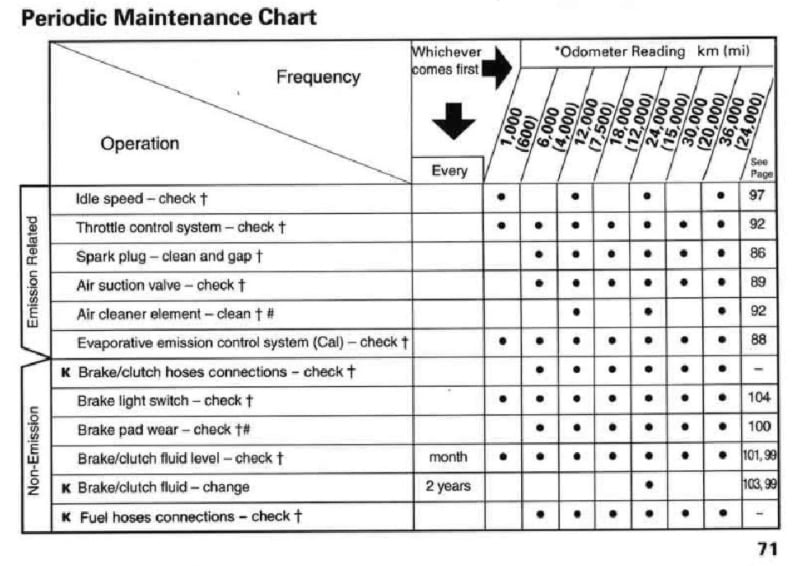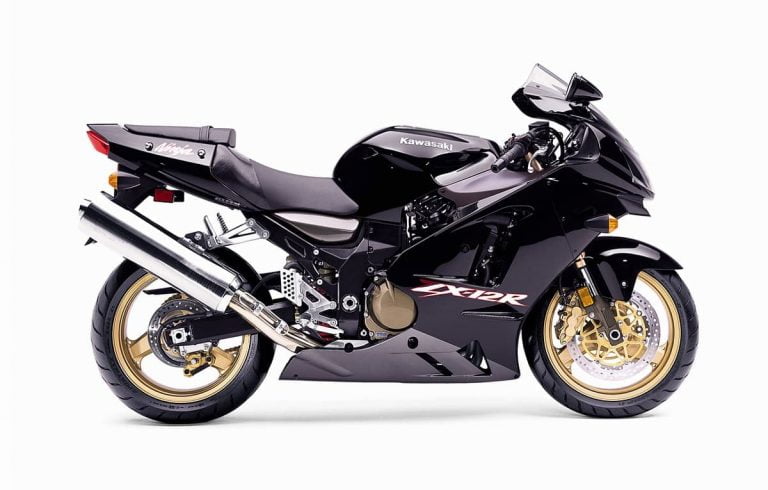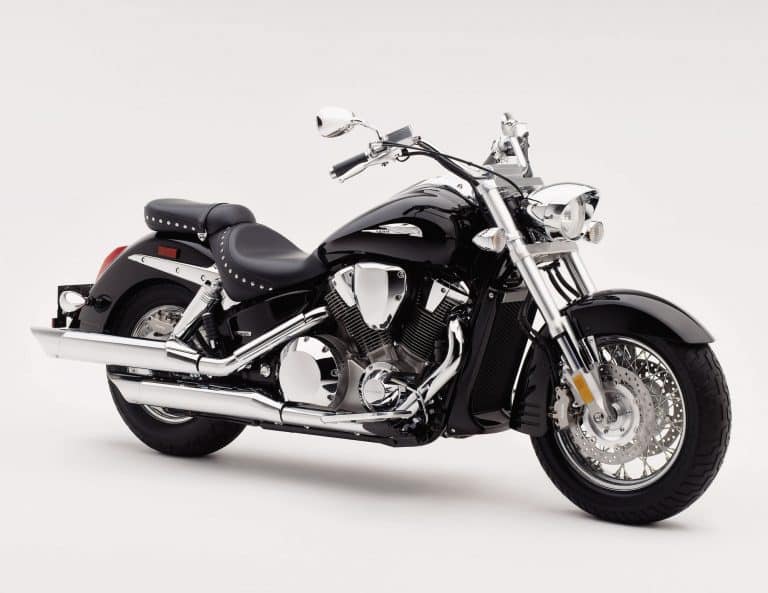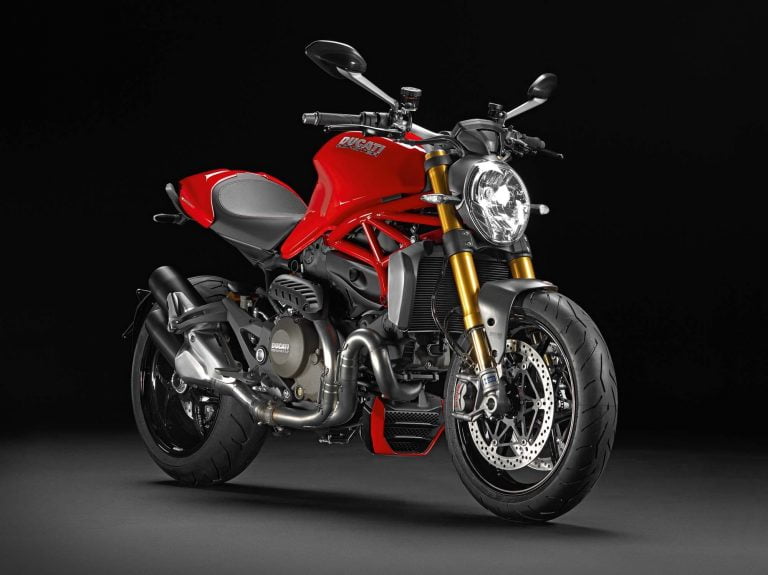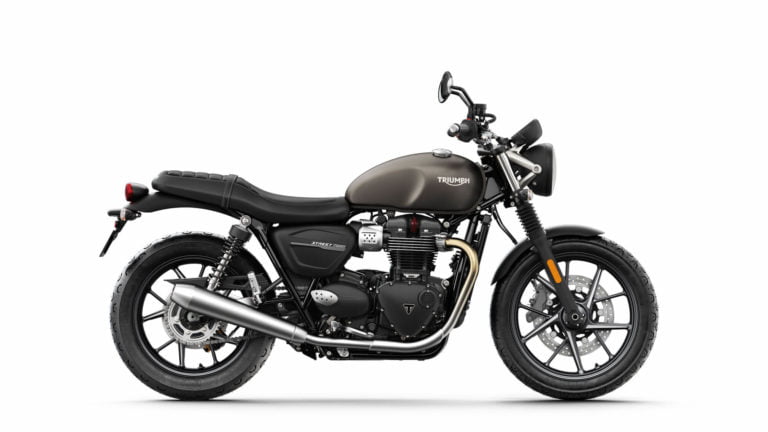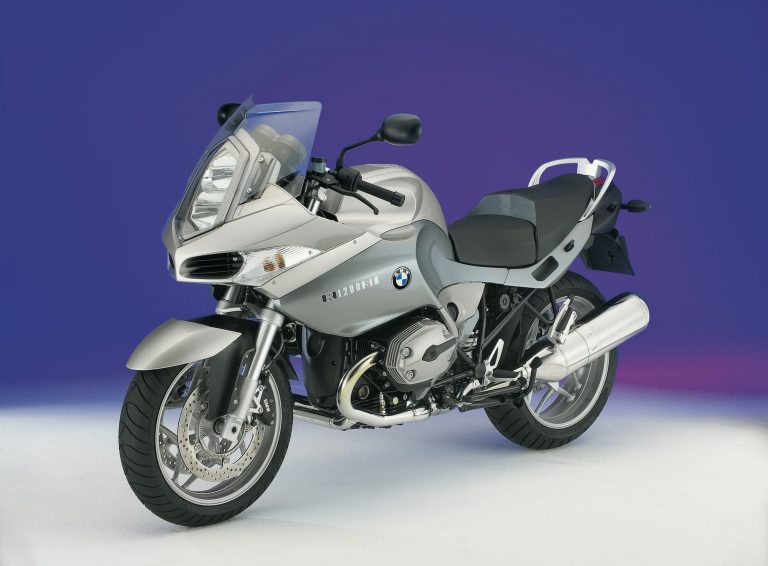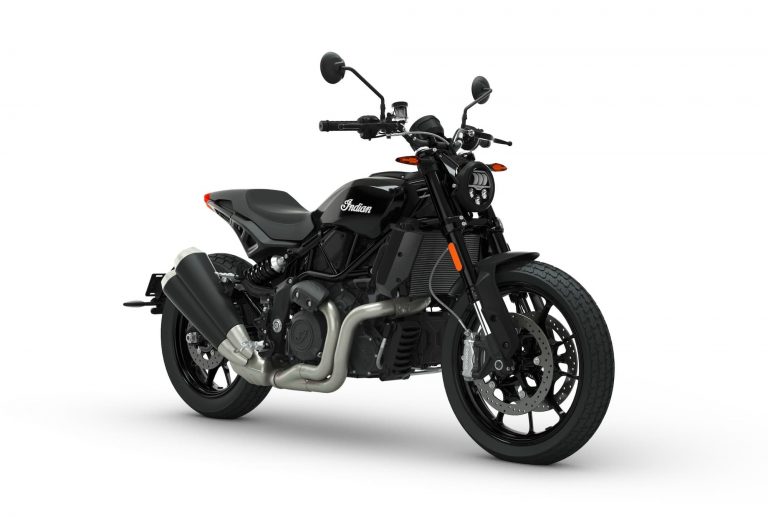Kawasaki Vulcan 1500 (Carburettor, pre-2005) Maintenance Schedule and Service Intervals
This is the maintenance schedule with associated service intervals for the Kawasaki Vulcan 1500 that was carburettor fed.
Before the Kawasaki Vulcan 1500 FI range, the Kawasaki Vulcan 1500 was fed by a single Keihin CVK40 carburettor, or twin CVK36 carbs in some configurations. The engine in the carburettor-fed Vulcan 1500 is a 1470 cc liquid-cooled V-twin with a single overhead cam and four valves per cylinder. It makes a claimed 48 kW / 64 hp at 4700 rpm, with peak torque of 112 Nm / 83 ft-lbs at 3000 rpm.
For a few years, the Vulcan 1500 was sold alongside the 1500 FI. They had the same capacity engine, but changes went beyond fuelling… the motorcycles had different frames and significant other body parts. It’s quite confusing and, in retrospect, entirely unnecessary. C’mon, Kawasaki!
Kawasaki made the Vulcan 1500 in a number of similar trims — Classic, Nomad, and Tourer. There’s also the Mean Streak, which has a higher-spec engine.
This site has links for things like oil and spark plugs from which we earn a commission (which unfortunately nobody can save, not even us). If you appreciate this work, then please use those links. Thanks!
Vulcan 1500 Service Intervals
In early years of the Vulcan 1500, Kawasaki recommended a 3000 mile / 5000 km service interval, but expanded this to 3500 mile / 6000 km in later years with no other changes to the motorcycle. So we use the latter of the two.
Every service, change the oil and clean the oil filter.
The Vulcan 1500 has a liquid-cooled engine, so keep the coolant fresh. But it also has self-adjusting hydraulic tappets, so has no valve service interval!
Maintenance Schedule for Kawasaki Vulcan 1500
Below is the maintenance schedule for the Kawasaki Vulcan 1500.
The following is the list of maintenance operations to be done on this motorcycle with a time or distance interval — whichever comes earlier.
The maintenance for the Kawasaki Vulcan 1500 Classic is broken into two sections: Emission Related, and Non-Emission Related.
Notes:
- For higher odometer readings, repeat at the frequency interval established here
- Kawasaki recommends that any service related to emissions or safety be done by an authorised dealer.
- For items marked “check”: Replace, adjust, or torque as necessary.
| mi x 1000 | 4 | 7.5 | 12 | 15 | 20 | 24 | |
|---|---|---|---|---|---|---|---|
| km x 1000 | 6 | 12 | 18 | 24 | 30 | 36 | Every |
| Engine oil — change | ✓ | ✓ | ✓ | ✓ | ✓ | ✓ | 6 months |
| Oil filter — replace | ✓ | ✓ | ✓ | ||||
| Spark plugs — clean and gap | ✓ | ✓ | ✓ | ✓ | ✓ | ✓ | |
| Air cleaner element — clean | ✓ | ✓ | ✓ | ||||
| Idle speed — check | ✓ | ✓ | ✓ | ||||
| Throttle grip play — check | ✓ | ✓ | ✓ | ||||
| Final gear case oil level — check | ✓ | ✓ | |||||
| Final gear case oil — change | ✓ | ||||||
| Propeller shaft joint — lubricate | ✓ | ✓ | |||||
| Air suction valve — check | ✓ | ✓ | ✓ | ✓ | ✓ | ✓ | |
| Evaporative emission control system (if fitted) — check | ✓ | ✓ | ✓ | ✓ | ✓ | ✓ | |
| Brake light switch — check | ✓ | ✓ | ✓ | ✓ | ✓ | ✓ | |
| Brake pad wear — check | ✓ | ✓ | ✓ | ✓ | ✓ | ✓ | |
| Brake hose, connections — check | ✓ | ✓ | ✓ | ✓ | ✓ | ✓ | |
| Brake/clutch fluid level — check | ✓ | ✓ | ✓ | ✓ | ✓ | ✓ | Month |
| Brake/clutch fluid — change | ✓ | 2 years | |||||
| Fuel hose, connections — check | ✓ | ✓ | ✓ | ✓ | ✓ | ✓ | |
| Steering — check | ✓ | ✓ | ✓ | ✓ | ✓ | ✓ | |
| Nut, bolt, fastener tightness — check | ✓ | ✓ | ✓ | ||||
| Spoke tightness and rim runout — check | ✓ | ✓ | ✓ | ✓ | ✓ | ✓ | |
| Tire wear — check | ✓ | ✓ | ✓ | ✓ | ✓ | ✓ | |
| General lubrication — perform | ✓ | ✓ | ✓ | ||||
| Front fork oil — change | ✓ | 2 years | |||||
| Front fork oil leak — check | ✓ | ✓ | ✓ | ||||
| Rear shock absorber oil leak — check | ✓ | ✓ | ✓ | ||||
| Swingarm pivot — lubricate | ✓ | ✓ | |||||
| Coolant — change | ✓ | 2 years | |||||
| Radiator hoses, connections — check | |||||||
| Steering stem bearing — lubricate | ✓ | 2 years | |||||
| Brake/clutch master cylinder cup and dust seal — replace | |||||||
| Coolant filter — clean | Year | ||||||
| Caliper piston seal and dust seal — replace | 4 years | ||||||
| Clutch slave cylinder piston seal — replace | 4 years |
Tire size and tire pressure for the Kawasaki Vulcan 1500
The Kawasaki Vulcan 1500 wears tube-type cruiser tyres, originally Bridgestone Exedra G30 or Dunlop D404s.
It has the following tyre sizes and pressures as standard:
| Wheel | Tire size | Tire pressure (cold) |
|---|---|---|
| Front | 130/90-16 67H | 28 psi / 200 kPa / 2 bar |
| Rear | 150/80 B16 71H | 36 psi / 250 kPa / 2.5 bar |
About the Kawasaki Vulcan 1500
The carburettor-fed Kawasaki Vulcan 1500 is a now classic Kawasaki cruiser the likes of which the Japanese brand no longer makes.
It’s quite a stunning bike, and there’s a lot to like about it — reliable, torquey liquid-cooled engine, shaft final drive, and those classic looks that still draw attention if you’re lucky enough to see one.
The Vulcan 1500 is powered by a 1470 cc liquid-cooled SOHC 50-degree V-twin engine with a single-pin crankshaft. It has four valves per cylinder and a nearly square design, with a bore and stroke of 102 x 90 mm. The final drive is via a 5-speed transmission and a shaft, meaning it’s quite a low-maintenance motorcycle — especially taking into account the low 8.6:1 compression ratio.
The Vulcan 1500 gets lots of attention for its looks, its technical features, and power.
In terms of looks, there’s quite a lot that makes the Vulcan 1500 unique. The cylinders have polished cooling fins that contrast with the black cast engine. The fins are functional, but there’s of course a radiator hidden between the frame down-tubes, in a neat way that many more modern liquid-cooled V-twin cruisers fail to echo.
The suspension is basic but functional on the Vulcan 1500, just as you’d expect on most cruisers. At the front, there’s a 41mm standard telescopic fork, and at the arm, there are twin shocks with 5-way adjustable preload.
Front brake is via a very simple single 300 mm disc with a 2-piston calliper, and at the rear there’s a single 270-mm disc with a 1-piston calliper. So it won’t stop on a dime at a racetrack… but that’s not the point of the Vulcan 1500.
What’s crazy about the Vulcan 1500 is just how long a tenure it had. Kawasaki made it from 1987 to 2004 in this format with its carburettor-fed engine.
In its early days, the 1470 cc engine displacement was massive, bigger than anything from Harley-Davidson at the time (though everyone has since made bigger, more powerful engines).
But despite the big displacement, the Kawasaki Vulcan 1500 isn’t just a big bruiser. It has lots of tech in the engine, like hydraulic valve lash adjusters, liquid cooling, and four valves per cylinder.
Screenshots from the Manual for the Kawasaki Vulcan 1500 (Carburettor)
The above maintenance schedule comes directly from the user’s manual for the 2000-2005 Kawasaki Vulcan 1500 manuals, comparing the maintenance schedule between them. We looked at the manuals for the other variants of the Vulcan 1500 to be sure.
You can see manuals for Kawasaki motorcycles here.
